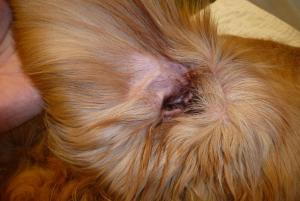Ear Infections in Dogs and Cats
- posted: Mar. 01, 2016

Otitis in Pets
Your dog is constantly shaking his head, scratching his ears, or rubbing his head on the floor. Your cat is digging in her ears with her back paw and holds her ears flat like “airplane ears.” What could be causing this crazy behavior?
Most people automatically think of ear mites, and, while some dogs and cats, especially kittens, may have ear mites, they are much less common than other causes of ear infection.
So, what else may be causing itchy, smelly ears? Bacterial and yeast infections are the other culprits. These organisms invade the lining of the ear causing redness, itchiness, swelling and odor and there is often black or yellowish debris or wax in the ear canals. Occasionally, a polyp or tumor may cause problems.
Several underlying conditions can cause ear infections in dogs and cats. Moisture or water getting into the ears such as when a pet gets a bath or goes swimming can fail to evaporate and set up a warm, moist place in the ear canal allowing yeast and bacteria to grow. A foreign object in the ear canal such as an insect or a piece of plant material, or excessive hair growing in the ear canal can also lead to infection. Finally, allergies to foods or to things in the environment like grasses, weeds, or molds, may cause secondary irritation to the ears and, in turn, infection can develop. Dogs with long, heavy ears like Spaniels and Retrievers tend to have more problems than dogs with erect ears like German Shepherds.
If you suspect an ear infection, make an appointment for your pet with your veterinarian. Ear infections are one of the most common problems seen daily at Patton Veterinary Hospital. That’s a lot of pets with sore ears in York County! The vet will examine your pet’s ears with an otoscope (a special magnifying light) to see if there are any mites present, to gauge the extent of infection, and to try to see if the ear drums are intact. We will also take a sample of the wax or debris within the ear canals to do a microscopic exam to determine the type and severity of the infection by counting the number of organisms in the ears. Once we know what kind of infection your pet has, appropriate treatment can begin.
Patton Veterinary Hospital frequently uses a treatment called an ear packing. This is a thick, Vaseline-like substance, containing a steroid to decrease redness and itching, an antibiotic and an antifungal drug. This medication is put into the ears at the appointment. It may cause some very mild discomfort when first applied, but this quickly disappears. The medication is very thick so it goes deep into the canal and it will stay in the canal for about two weeks. In very rare cases, this medication as well as some other topical ear drops may cause a temporary loss of hearing, but, in general, side effects are rare. Other treatments such as ear drops, oral antibiotics, or steroid pills may also be necessary.
Almost all patients should return two to three weeks later to have their ears rechecked to make sure the infection has resolved. Failure to return for recheck appointments makes it much more difficult to clear up all but the mildest of ear infections. Ear infections are uncomfortable for your pet and that constant head shaking can drive you crazy, too! Make an appointment if you think your pet may have an ear infection so he or she may be properly treated and feel better soon.
This blog brought to you by the Patton Veterinary Hospital, serving Red Lion, York and the surrounding communities. 
Location
Patton Veterinary Hospital
425 E Broadway
Red Lion, PA 17356
